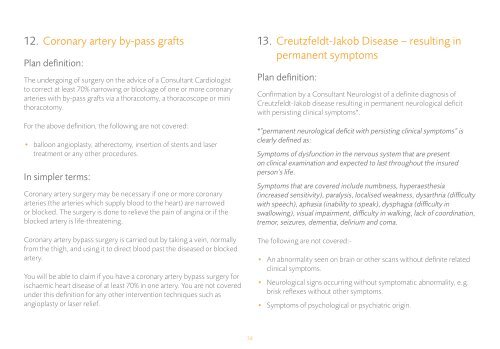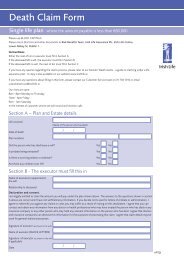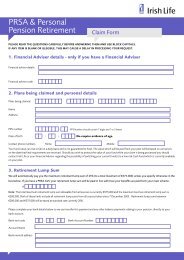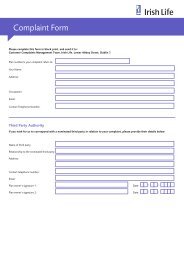Mortgage Protection booklet - Irish Life
Mortgage Protection booklet - Irish Life
Mortgage Protection booklet - Irish Life
Create successful ePaper yourself
Turn your PDF publications into a flip-book with our unique Google optimized e-Paper software.
12. Coronary artery by-pass grafts<br />
Plan definition:<br />
The undergoing of surgery on the advice of a Consultant Cardiologist<br />
to correct at least 70% narrowing or blockage of one or more coronary<br />
arteries with by-pass grafts via a thoracotomy, a thoracoscope or mini<br />
thoracotomy.<br />
For the above definition, the following are not covered:<br />
• balloon angioplasty, atherectomy, insertion of stents and laser<br />
treatment or any other procedures.<br />
In simpler terms:<br />
Coronary artery surgery may be necessary if one or more coronary<br />
arteries (the arteries which supply blood to the heart) are narrowed<br />
or blocked. The surgery is done to relieve the pain of angina or if the<br />
blocked artery is life-threatening.<br />
Coronary artery bypass surgery is carried out by taking a vein, normally<br />
from the thigh, and using it to direct blood past the diseased or blocked<br />
artery.<br />
You will be able to claim if you have a coronary artery bypass surgery for<br />
ischaemic heart disease of at least 70% in one artery. You are not covered<br />
under this definition for any other intervention techniques such as<br />
angioplasty or laser relief.<br />
34<br />
13. Creutzfeldt-Jakob Disease – resulting in<br />
permanent symptoms<br />
Plan definition:<br />
Confirmation by a Consultant Neurologist of a definite diagnosis of<br />
Creutzfeldt-Jakob disease resulting in permanent neurological deficit<br />
with persisting clinical symptoms*.<br />
*”permanent neurological deficit with persisting clinical symptoms” is<br />
clearly defined as:<br />
Symptoms of dysfunction in the nervous system that are present<br />
on clinical examination and expected to last throughout the insured<br />
person’s life.<br />
Symptoms that are covered include numbness, hyperaesthesia<br />
(increased sensitivity), paralysis, localised weakness, dysarthria (difficulty<br />
with speech), aphasia (inability to speak), dysphagia (difficulty in<br />
swallowing), visual impairment, difficulty in walking, lack of coordination,<br />
tremor, seizures, dementia, delirium and coma.<br />
The following are not covered:-<br />
• An abnormality seen on brain or other scans without definite related<br />
clinical symptoms.<br />
• Neurological signs occurring without symptomatic abnormality, e.g.<br />
brisk reflexes without other symptoms.<br />
• Symptoms of psychological or psychiatric origin.

















